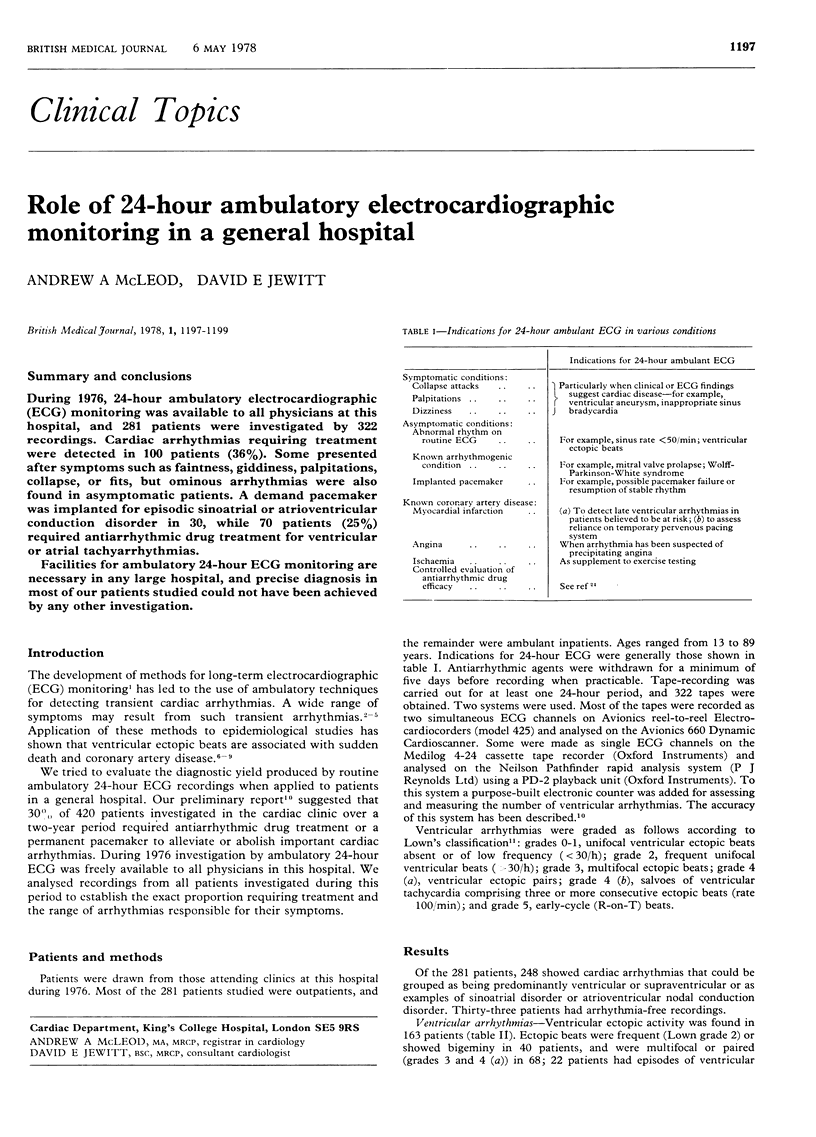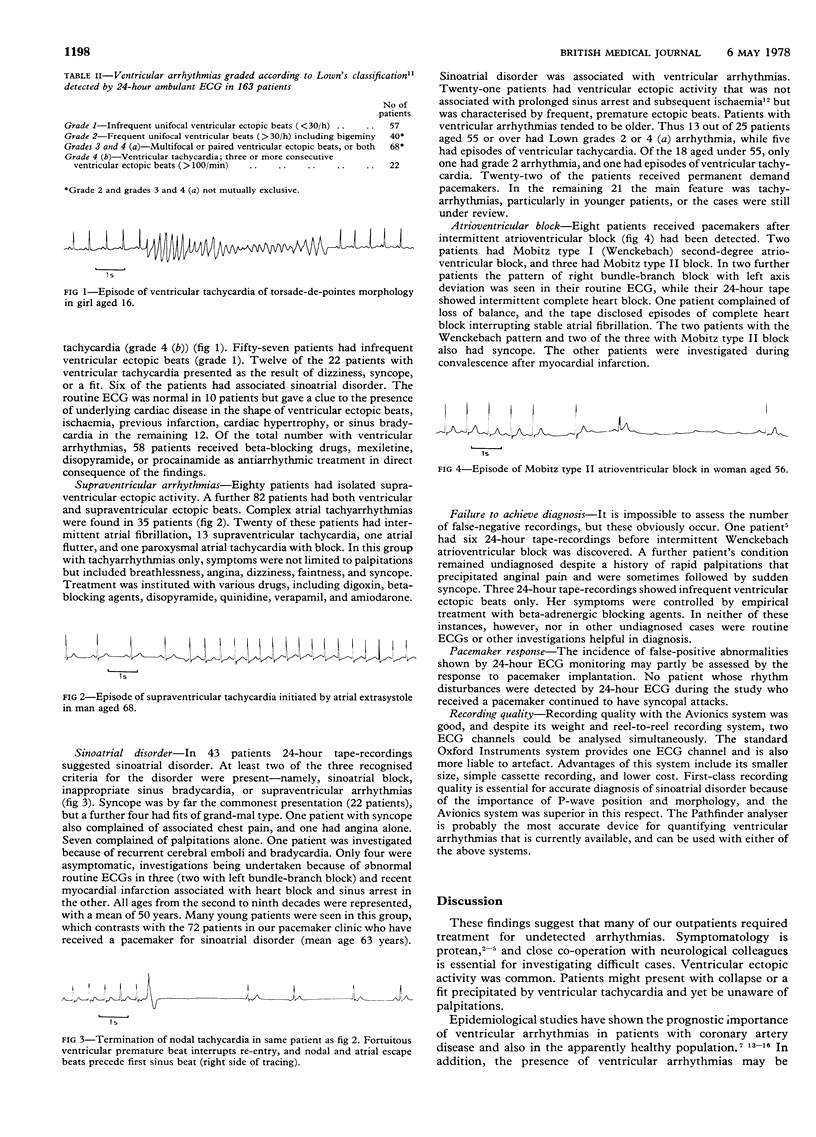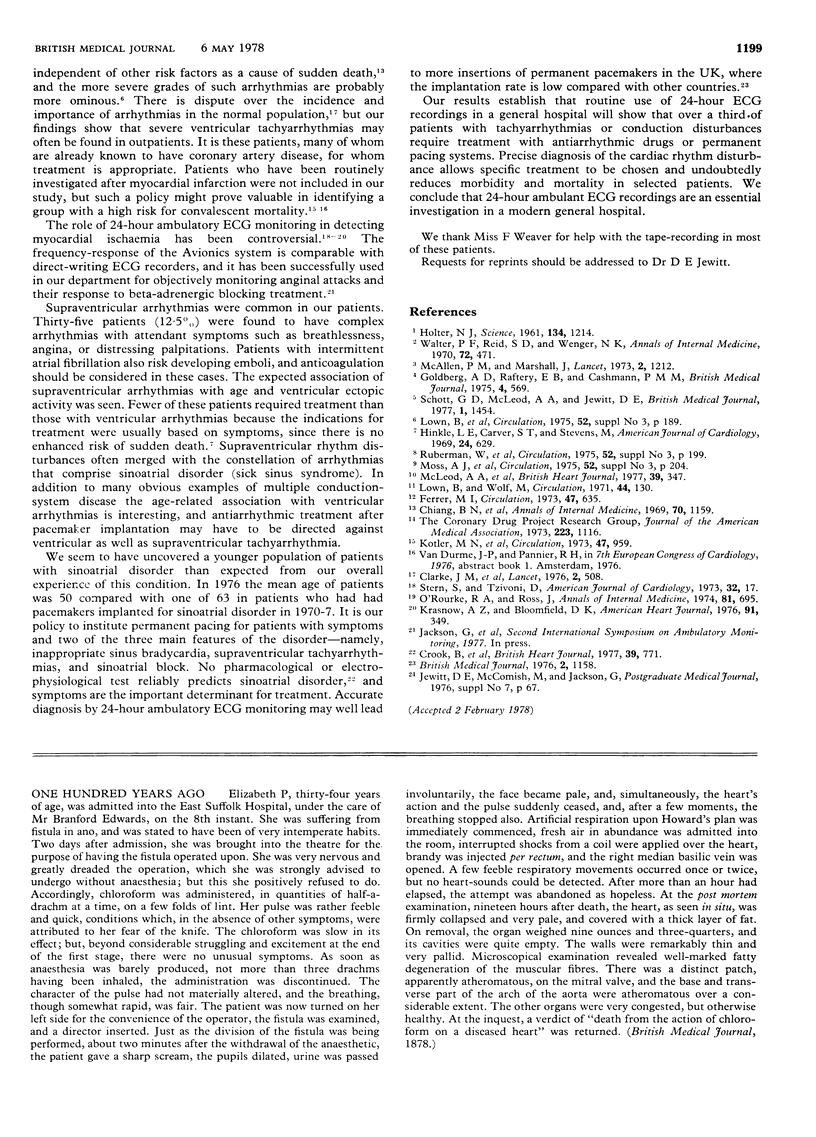Abstract
During 1976, 24-hour ambulatory electrocardiographic (ECG) monitoring was available to all physicians at this hospital, and 281 patients were investigated by 322 recordings. Cardiac arrhythmias requiring treatment were detected in 100 patients (36%). Some presented after symptoms such as faintness, giddiness, palpitations, collapse, or fits, but ominous arrhythmias were also found in asymptomatic patients. A demand pacemaker was implanted for episodic sinoatrial or atrioventricular conduction disorder in 30, while 70 patients (25%) required antiarrhythmic drug treatment for ventricular or atrial tachyarrhythmias. Facilities for ambulatory 24-hour ECG monitoring are necessary in any large hospital, and precise diagnosis in most of our patients studied could not have been achieved by any other investigation.
Full text
PDF


Selected References
These references are in PubMed. This may not be the complete list of references from this article.
- Chiang B. N., Perlman L. V., Ostrander L. D., Jr, Epstein F. H. Relationship of premature systoles to coronary heart disease and sudden death in the Tecumseh epidemiologic study. Ann Intern Med. 1969 Jun;70(6):1159–1166. doi: 10.7326/0003-4819-70-6-1159. [DOI] [PubMed] [Google Scholar]
- Clarke J. M., Hamer J., Shelton J. R., Taylor S., Venning G. R. The rhythm of the normal human heart. Lancet. 1976 Sep 4;1(7984):508–512. doi: 10.1016/s0140-6736(76)90801-1. [DOI] [PubMed] [Google Scholar]
- Ferrer M. I. The sick sinus syndrome. Circulation. 1973 Mar;47(3):635–641. doi: 10.1161/01.cir.47.3.635. [DOI] [PubMed] [Google Scholar]
- Goldberg A. D., Raftery E. B., Cashman P. M. Ambulatory electrocardiographic records in patients with transient cerebral attacks or palpitation. Br Med J. 1975 Dec 6;4(5996):569–571. doi: 10.1136/bmj.4.5996.569. [DOI] [PMC free article] [PubMed] [Google Scholar]
- HOLTER N. J. New method for heart studies. Science. 1961 Oct 20;134(3486):1214–1220. doi: 10.1126/science.134.3486.1214. [DOI] [PubMed] [Google Scholar]
- Hinkle L. E., Jr, Carver S. T., Stevens M. The frequency of asymptomatic disturbances of cardiac rhythm and conduction in middle-aged men. Am J Cardiol. 1969 Nov;24(5):629–650. doi: 10.1016/0002-9149(69)90451-2. [DOI] [PubMed] [Google Scholar]
- Kotler M. N., Tabatznik B., Mower M. M., Tominaga S. Prognostic significance of ventricular ectopic beats with respect to sudden death in the late postinfarction period. Circulation. 1973 May;47(5):959–966. doi: 10.1161/01.cir.47.5.959. [DOI] [PubMed] [Google Scholar]
- Lown B., Wolf M. Approaches to sudden death from coronary heart disease. Circulation. 1971 Jul;44(1):130–142. doi: 10.1161/01.cir.44.1.130. [DOI] [PubMed] [Google Scholar]
- McAllen P. M., Marshall J. Cardiac dysrhythmia and transient cerebral ischaemic attacks. Lancet. 1973 Jun 2;1(7814):1212–1214. doi: 10.1016/s0140-6736(73)90527-8. [DOI] [PubMed] [Google Scholar]
- O'Rourke R. A., Ross J., Jr Ambulatory electrocardiographic monitoring to detect ischemic heart disease. Ann Intern Med. 1974 Nov;81(5):695–696. doi: 10.7326/0003-4819-81-5-695. [DOI] [PubMed] [Google Scholar]
- Schott G. D., McLeod A. A., Jewitt D. E. Cardiac arrhythmias that masquerade as epilepsy. Br Med J. 1977 Jun 4;1(6074):1454–1457. doi: 10.1136/bmj.1.6074.1454. [DOI] [PMC free article] [PubMed] [Google Scholar]
- Walter P. F., Reid S. D., Jr, Wenger N. K. Transient cerebral ischemia due to arrhythmia. Ann Intern Med. 1970 Apr;72(4):471–474. doi: 10.7326/0003-4819-72-4-471. [DOI] [PubMed] [Google Scholar]


